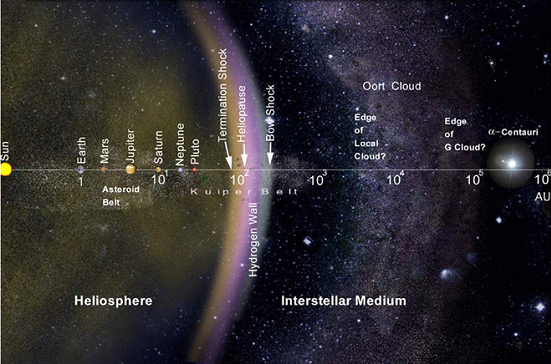|

A schematic of the Solar System out
to the nearest star. Credit: NASA
A Spectre Haunts the Darkness
Jun
01, 2011
Could a giant planet be
lurking at the outer boundaries of a
hypothetical cometary cloud?
The Oort Cloud is supposed to be a giant nimbus of small fragments left over
from those early days when the Sun was a newborn star. It is said to be a
spherical region enclosing the Sun at a maximum radius of about 5 trillion
kilometers and contains billions of objects, some as big as small planets, but
most around the size of a medium asteroid.A recently
published paper seeks to explain the appearance of comets passing through
the inner Solar System by invoking the occasional influence of a solar companion
that could be larger than the planet Jupiter. That theoretical object nudges the
Oort cloud, causing one or more of its frozen denizens to be dislodged from its
orbit and begin falling toward the Sun.
The reason such a large planet
was proposed is because more than
25% of observed comets would require
at least that much gravitational
impetus for them to change their
motion around the Sun. However,
since stars are nodes in vast
electrical circuits connected by
Birkeland current filaments within
galaxies, their attendant planets,
moons, asteroids, and comets are
electrically charged and exist
within a radial electric current
that surrounds most stars, including
our own Sun.
Comets, specifically, have nothing
to do with an ancient nebular cloud
of cold gas and dust that became
gravitationally unstable and
collapsed into the Solar System of
today. Comets and their asteroid
sisters are relative newcomers to
the solar family and might have been
blasted out of larger bodies by
tremendously powerful electric
discharges in the recent past. They
are not "snowballs" or blobs of
muddy slush, they are solid, rocky,
cratered, electrically charged
objects.
Several previous Picture of the Day
articles have dealt with the
problems that the frozen ice and mud
comet model incite. The observed
high-energy cometary events require
a new understanding of what makes a
comet work: X-rays, an ultraviolet
coma several times the size of the
Sun, turbulent magnetic fields,
million degree “temperatures” in the
coma, collimated, supersonic jets,
filamentary tails stretching out to
one hundred million kilometers, the
break up and complete disintegration
of comet nuclei far from the Sun,
sharply etched surface relief, and
bright surface patches that overload
camera optics are a few points that
cannot be adequately explained using
conventional theories.
An electrical model of comets fits
the bill quite well when it comes to
gathering the collection of
phenomena under one roof.
Electric Universe advocate
Wal Thornhill asks: "How many surprises
and disconfirmations of cherished beliefs about comets will it require before a
fundamental rethink occurs, instead of mere revision of old ideas"?An
electric comet must exist within an
electric Solar System powered by an
electric Sun that receives energy
from the electric Milky Way galaxy.
The galaxy, in turn, is supplied
with external power from tremendous
Birkeland current filaments that
span the Universe, carrying
electricity along virtual
transmission lines a billion light
years long. This viewpoint is not
countenanced by consensus opinions
because it means a shift in the
foundations of thinking.
There is little in astronomical
theories that can meet the test of
new information. The flood of data
from space-borne telescopes and
telemetry from remote sensors, some
orbiting other planets, has
literally overloaded the scientific
establishment. New ideas must always
be given their place.
As philosopher Paul Feyerabend
wrote:
"Given any rule, however
'fundamental' or 'necessary' for
science, there are always
circumstances when it is advisable
not only to ignore the rule, but to
adopt its opposite."
Stephen Smith
 New
DVD New
DVD
The Lightning-Scarred
Planet Mars
A video documentary that could
change everything you thought you
knew about ancient times and
symbols. In this second episode of
Symbols of an Alien Sky, David
Talbott takes the viewer on an
odyssey across the surface of Mars.
Exploring feature after feature of
the planet, he finds that only
electric arcs could produce the
observed patterns. The high
resolution images reveal massive
channels and gouges, great mounds,
and crater chains, none finding an
explanation in traditional geology,
but all matching the scars from
electric discharge experiments in
the laboratory. (Approximately 85
minutes)
Video Selections
Order Link
|





 New
DVD
New
DVD

